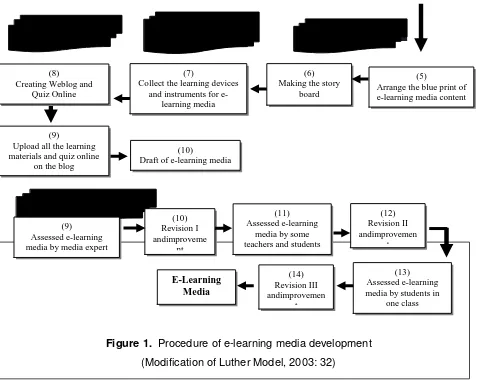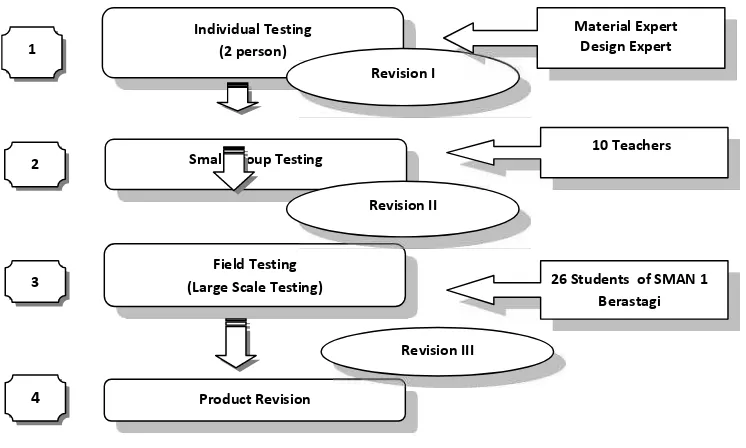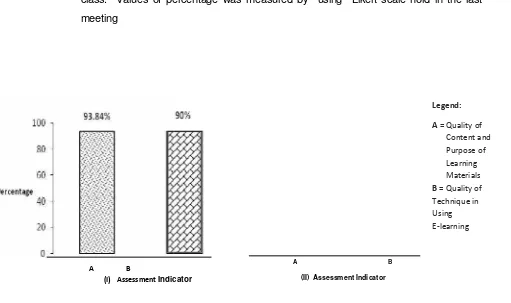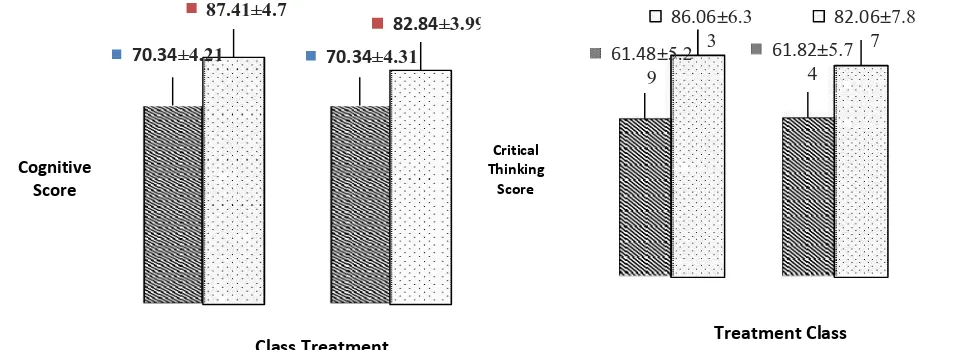Prosiding Seminar Nasional Biologi dan Pembelajarannya Medan, 23 Agustus 2014
MAKALAH PENDAMPING
#4
Prosiding Seminar Nasional Biologi dan Pembelajarannya Medan, 23 Agustus 2014
Jurusan Biologi FMIPA Universitas Negeri Medan
The Character Building Univesity
372
THE DEVELOPMENT OF E-LEARNING MEDIA AND ITS EFFECT ON
STUDENT’S LEARNING ACHIEVEMENT AND CRITICAL THINKING IN GRADE
XI IA SMAN 2 BALIGE
Wenny Pintalitna
Biology Education Department, PPs UNIMED Medan. Jl.Willem Iskandar Pasar V Medan 20221. Email: [email protected]
ABSTRACT
The type of this study was Research and Development. This study has purpose to develop e-learning media of digestive system and know its effect on learning achievement and critical thinking skills in grade eleventh SMAN 2 Balige. For developmental stage, e-learning media was developed by Luther model. Questionnaire was the instrument that used in validation stage. Result of expert assessment showed that screen design effectiveness 66%; media operation 80 %; format and organizing 80%; content assessment 82.5 %. Average percentage of small and large validation were 93%, it means e-Learning media showed categorized as good. After e-learning media stated as valid, it was implemented to see the effect of e-learning media toward the learning achievement and critical thinking. Sample was class XI IA 2 and XI IA 3. The data were analyzed quantitative and qualitatively. Instrument test used consists of cognitive and critical thinking test. Average of post test for cognitive test and critical thinking in experimental group was higher than control group. There was significant difference of students’ learning achievement and critical thinking skill that taught by using e-learning media.
ABSTRAK
Prosiding Seminar Nasional Biologi dan Pembelajarannya Medan, 23 Agustus 2014
Jurusan Biologi FMIPA Universitas Negeri Medan
The Character Building Univesity
373
penelitian ini yaitu kelas XI IA 2 dan XI IA 3. Teknik analisis data secara kuantitatif dan kualitatif. Uji Instrumen menggunakan tes kognitif dan tes berpikir kritis. Rata-rata nilai post tes untuk tes kognitif dan berpikir kritis pada kelompok eksperimen lebih tinggi dari pada kelompok kontrol. HaI ini menunjukkan adanya perbedaan yang signifikan pada hasil belajar siswa dan keterampilan berpikir kritis yang diajarkan dengan menggunakan media e-Learning.
Keywords:e-learning media, group investigation
INTRODUCTION
Biology is a subject-specific knowledge of biological systems and concepts that provide the knowledge, skills, responsibilities to the environment, and process of discovery (Budimansyah, 2002:34). This course allows students to develop practical and technical skills from laboratory sessions, communication skills are learned through report writing and making presentations, teamwork skills are developed through group projects and seminars, problem-solving skills are obtained from critical analysis to a case.
Learning of biology should be carried out with emphasis on the direct learning experience through the development of process skills and scientific attitudes that needs critical thinking skill (BSNP, 2006). The facts indicate that the learning of biology conducted predominant in the memorizing the concept. Students have not been teached to understand the information and relate it to life. Science lessons at school are more geared to the mastery of knowledge and lack of developing a scientific attitude (Meita, 2012:1). The National Assessment of Educational Progress (NAEP) as the nation’s report card in America reported that the development of advanced reasoning abilities has declined in 12thgrader because students did not learn how to think.
The interview result with biology teachers in SMAN 2 Balige obtained percentage of students that did not fulfill the score criteria of minimum completeness (KKM) 76 on semester final exam 2010/2011 was 48% in grade eleventh. The results of the National Final Examination (UN) 2009/2011 for Science lesson that achieved by students were relatively low. Biology was the most potentially lesson lead to failure when compared to Physics and Chemistry (Source: BSNP Puspendik). Studies of science teaching in the late 1990 led to the observation that most teachers used the didactic methods of instruction and determined that ‘‘many students were low learning achievement, mastering disconnected facts in understandings and problem solving skills’’ (National Research Council, 2000:17).
Prosiding Seminar Nasional Biologi dan Pembelajarannya Medan, 23 Agustus 2014
Jurusan Biologi FMIPA Universitas Negeri Medan
The Character Building Univesity
374
critical thinking skill (Lazarowitz, 1992). Digestive system topic is categorized difficult to comprehend because of its complicated characteristics which deal with complex physical and chemical mechanisms. It was supported by the low of average percentage achievement of National Examination 2008/2009 on digestive system topic in some areas like as Kab Nias, Kab. Binjai, Kab.Siantar and Kab.Tobasa are 64% that can reach KKM (PPMP, 2009).
The increasing of student’s learning achievement and critical thinking in the learners necessary change in methods, models and learning media at school. Most of teachers in SMA Negeri 2 Balige used teacher centered learning approach thus created the passive learners focused on teacher, learners were not pushed to think critically. Learning media used by teacher was not internet based and did not stimulate student’s critical thinking skill yet (Source: prelimiery observation).
Group Investigation (GI) learning model provides students to discuss and solve the physiological abstract concepts, cognitive restructuring leads, enhance elaborative thinking, more receiving of explanation which has potential to foster student’s understanding and critical thinking (Johnson,1986). Group Investigation assissted learning media characterized by decisions that are developed by the group experience in the context of problems that become a central point in learning activities. The primary responsibility of teachers is to motivate students to work cooperatively and to solve the problems critically that go on in learning. In this class discussion is considered the priority of students’ thinking exchange. Research by Johnson (1991) showed that cooperative learning assissted media enhanced more positive learning result in each learner. One of learning media is computer assissted.
Computer-assisted teaching using internet (e-learning) can construct a new learning style. The e-Learning media is more superior than the other learning media because this media contents illustrate and combine sound, image, picture, motion and words, create life-time learning model in which the learner is the center of learning activities (Jhang,2004). E-learning assists cognitive construction, developed by resource sharing and quiz online. (Pazos, 2002:34). These facilities help students to discuss and find the answer in group discussion about complex science issues faced. Learning of complex science issues requires deeply entrenched intuitive conceptions. This kind of learning is referred to as conceptual change (Limon & Mason, 2002).
I. Need Assessment Concept Stage
(1) Literature Study and Observation
(2) Knowledge about learning assisted internet
(3) Analysis of Student
Characteristics
Prosiding Seminar Nasional Biologi dan Pembelajarannya Medan, 23 Agustus 2014
Jurusan Biologi FMIPA Universitas Negeri Medan
The Character Building Univesity
375
Figure 1. Procedure of e-learning media development (Modification of Luther Model, 2003: 32)
Information and Communication Technologies (ICT) enable multiple representations of experimental concepts and enable the creation of problem solving applications (Duit, 1995). Hestenes (1999) stated that most science problems were solved through the selection of a model that provided the answer to the problem following model-based inference. ICT actively involves students in the research process and gives teachers the opportunity to work under conditions that could not be traced in a traditional learning environment.
e-Learning media helps students to comprehend the learning topic easier so improving students’ learning achievement and critical thinking skills. e-Learning media can be used as an interactive learning media by optimizing facilities and infrastructure in schools that can support the learning process.
III. Material Collecting
Prosiding Seminar Nasional Biologi dan Pembelajarannya Medan, 23 Agustus 2014
Jurusan Biologi FMIPA Universitas Negeri Medan
The Character Building Univesity
376
METHODOLOGY
Questionnaires for assessing e-Learning media tested to 58 students in class XI IA 2 and XI IA 3 at SMAN 2 Balige were determined by Likert scale. The sample was selected by random cluster sampling. Instrument for assessing students’ learning achievement and critical thinking skills were multiple choice and essay test. The development of e-learning media used Luther (2003:32) model consisted of five stages namely need assessment, planning, material collecting, assembly, developmental stage than can bee seen in Figure 1.
e-Learning media created was validated in small and large scales. The revision process of e-learning media can be seen in Figure 2.
Figure 2. Validation process of e-Learning media
Pre test and post test were administered both of experimental and control class before and after treatment that can be seen detail in this following Table 1.
Table 1. Experimental research design
Group Pre Test Treatment Post Test
E √ X √
C √ Y √
Note: E = Experimental Class C = Control Class
X = Group Investigation assissted e-Learning media
Field Testing (Large Scale Testing)
(26 person)
3 26 Students of SMAN 1
Berastagi
as sample
Product Revision
4
Revision III Small Group Testing
(20 person) Revision II
2 10 Teachers
10 Students Individual Testing
(2 person)
Revision I
Medan, 23 Agustus 2014
Jurusan Biologi FMIPA Universita
The Character Building Univesity
377
Y = Group
Data was analyzed questionnaire and observa thinking determined by usi rejected. If tobs> ttable, HO w
RESULT
Result of Developmental R
Design of quiz online scree
The result of media assessment criteria for effe Figure 3. Screen design of
Figure
Video Prosiding Seminar Nasional Biolog
Medan, 23 Agustus 2014
itas Negeri Medan
The Character Building Univesity
377
up Investigation Learning Model
d by using normality, homogeneity test, and pe vation data. The increasing of learning achiev using t-test. If tobs< ttable, HO will be accepte
will be rejected and Ha will be accepted.
al Research
Based on the script written consisted of 3 parts, namely:
• Home contained learning mat downloaded in the home menu
• Digestive system articles in the information about digestive syst
• Menu of learning materials topic from grade X until grade X
een has been made can be seen in this followin
dia and content expert assessment, there wa ffectiveness screen design that should be revise of weblog
re 4. Screen design of quiz online
Video
ogi dan Pembelajarannya Medan, 23 Agustus 2014
The Character Building Univesity
377
percentage for each
s contained biology e XII.
wing Figure 4.
was indicators of the vised. They were the
Medan, 23 Agustus 2014
Jurusan Biologi FMIPA Universita
The Character Building Univesity
378
80% 100% 80%
Percentage
Assessment Indicator
A B C D E F G
introduction display and mu that did not necessary to be Percentage of stude GI learning model reached can be seen in this followin better result to student’s crit
Figure 5. E-learning media media evaluation). scale 1-5. The asse
Figure 6.E-learning media a evaluation). Value o The assessment wa
Prosiding Seminar Nasional Biolog
Medan, 23 Agustus 2014
itas Negeri Medan
The Character Building Univesity
378
80% 80%
music used in quiz online. In other hand there be revised from biology material content exper udent’s response to the implementation of e-le
d more than 85% prefer to study by using e-L ing Figure 8. The implementation of e-Learnin critical thinking.
dia assessment by media expert ( % values ref ). Value of assessment was measured by usi ssessment was conducted before treatment in SM
assessment by content expert ( % values refe e of assessment was measured by using Likert s was conducted before treatment in SMAN 2 Bali
Legend:
A= Effectiveness of S
B= E-learning Media
C= Consistency
The Character Building Univesity
378
A B C D E F G
re was some aspects ert.
-learning media and -Learning media that rning media gave the
refer to refer to the of using Likert scale with
SMAN 2 Balige
efer to the of content rt scale with scale 1-5.
Prosiding Seminar Nasional Biologi dan Pembelajarannya Medan, 23 Agustus 2014
Jurusan Biologi FMIPA Universitas Negeri Medan
The Character Building Univesity
379
380
The value of cognitive class can be seen in this follow
Legend:
ve test and critical thinking result both in contro llowing Figure 10 and Figure 11.
Legend: ositive and negative
381 was less of clarity and harmonio level of degree yet by researche learning evaluation easily durin email directly which made effi achieved with an average perc learning eventough should be re
•Media Expert
Media expert assessed th was caused the featured music text in blog and quiz online we were still two dimensions, the si e-learning media based on the categorized was feasible catego process eventhough should be r
Figure 10.Student s achievement ( ±SD) before (pre test) and after (post test) using e-Learning
media and without e-learning media. Values
of score was measured by using paired t-test with tobs= 4.015; p=0.05, n=29. Error bar indicates standard deviation.
Figure 11.Critical thinking ( ±SD) before (pre test) and after (post test) using e-learning media and
without e-Learning media. Values of score was measured by using paired tail t-test with tobs= 2.173; p=0.05, n=29. Error bar indicates standard deviation.
381
70.34±4.31
82.84±3.99
Class Treatment
expert assessment found that the learning mate nious. It was caused, the learning materials did no her. The assessor stated e-learning media provid ring learning in the class and the mark could be efficiency of time. The percentage of content a
rcentage of 82.5% categorized feasible and suit revised accordance with the suggestion given.
the effectiveness of weblog screen design was ic in blog was too loud, composition of backgroun were contrast and blur, quality of animation in b
size of font in quiz online was smaller. The feasi e aspects of visual; display aspect and design w gory. This meant that e-learning media fited for u e revised accordance with the advice.
Figure 10.Student s achievement ( ±SD) before (pre test) and after (post test) using e-Learning media and without e-learning media. Values
of score was measured by using paired t-test with tobs= 4.015; p=0.05, n=29. Error bar indicates standard deviation.
Figure 11.Critical thinking ( ±SD) before (pre test) and after (post test) using e-learning media and
without e-Learning media. Values of score was measured by using paired tail t-test with tobs= 2.173; p=0.05, n=29. Error bar indicates standard deviation.
381
aterials has uploaded not sort based on the vided teacher to make be sent into students’ t assessment aspect uitable as a media of .
s not enough good. It und color with color of blog and quiz online asibility of instructional were 73.63 % which r using during learning
Figure 10.Student s achievement ( ±SD) before (pre test) and after (post test) using e-Learning media and without e-learning media. Values
of score was measured by using paired t-test with tobs= 4.015; p=0.05, n=29. Error bar indicates standard deviation.
Figure 11.Critical thinking ( ±SD) before (pre test) and after (post test) using e-learning media and
382
• Students and Teachers
The result of e-learning media evaluation by ten students and teachers got the average percentage was 90% for quality of content and learning materials; 84% for indicator technical quality of e-learning media. It meant that the e-learning media categorized was very decent category. The assessment of students in SMAN 1 Berastagi was 93%. Students understood biology materials featured in the web blog and quiz online easily and were very interested in the answer the quiz in the quiz online because of the attractive display of e-learning media.
b. Experimental Research
•Learning response
Analysis of students’ learning response got data that 93.10 % of students prefer to study by using e-learning media during teaching and learning in the class and 89.65 % of students that give positive answer for implementing cooperative learning during teaching and learning in the class. Students felt good when learning by using e-learning media tested caused e-learning media gave students more opportunity to learn, the existence of feedback to students work. In other hand, learning without assisted e-learning media gave low contribution in the fostering student’s learning response. Problem cases in the article and worksheet given by teacher can foster students’ critical thinking and motivation in learning.
•Learning Achievement and Critical Thinking
The result showed that there was influence of using e-learning media to the student’s learning achievement and critical thinking on the digestive system topic in grade eleventh semester II SMAN 2 Balige. Based on the observation, all critical thinking attitude items (100%) appear in the experimental and control in the last meeting. The treatment in the control and experimental gave the influence to student’s learning achievement and critical thinking skill. Learning which emphasizes self-learning could encourage students to learn better. It is proved by opinion Hijazi (in Asandulul & Ceobanu, 2008:44) states that students wish to have a more substantial offer concerning such courses and, consequesntly, the participation could be greater. The increase of the technology will contribute to the technological competence of the student. Thus, students may demand implementation of more sophisticated technolo-gical equipment in the educational environment.
383
e-Learning media also developed by biology article, quiz online and biology learning video. The questions in the quiz online and problems like as study case written by teacher in box chatting involved students to answer the problem by using critical answer that need critical thinking. Students could access the previous learning topic in the home so enrichment of learning materials not only focusedmon the handbook and textbook of student from school. Rusyan Saragih (2010) states the students have had the potential within themselves to find their own learning information independently. The interactive media could provide a way to convey and clarify the concept, train students to become more effective in developing the concept. This learning method also increased the motivation to learn which was characterized by high student’s learning response in the classroom.
CONCLUSION AND RECOMENDATION
E-learning media was created is very effective as an interactive learning media. The use of Group Investigation assisted e-learning media has a positive effect on student’s learning achievement and critical thinking. Implementation of interactive learning media in class has able to stimulate the student’s critical thinking attitude.
Biology teachers should apply the innovative learning media like e-learning media to improve student’s learning achievement and critical thinking.
REFERENCES
Arikunto, S.2003. Prosedur Penelitian Suatu Pendekatan Praktek. Jakarta: Rineka Cipta. Arikunto, S. 2009.Dasar-dasar Evaluasi Pendidikan. Jakarta: Bumi Aksara.
Bates and Wulf. 1996. Web-Based Instruction. Educational Technology Publications. New Jersey: Englewood Cliffs.
Brown, Sally. 2003.Computer Assisted Assessment in Higher Education.New Delhi: Cres Publishing House.
Bull, J. et al. 2003. “Assessing Learners Through the WWW, Computer Networks and ISDN Systems.”Journal of Educational Technology and Society,3:1-7 ( http://www. jtla.org, accessed 28thDecember 2011).
Djamarah. 2002.Strategi Belajar Mengajar. Jakarta: Rineka Cipta.
Dongsong, Z. et al. 2005. “Instructional video in e-learning: Assessing the impact of interactive video on learning effectiveness.” Journal of the Learning Sciences, 43 (2006) 15–27. Tersedia pada http://www.elsevier.com/locate/dswhtml,accessed 28thDecember 2011
384
(http://www.edweek.org/ew/index.html, accessed 28thDecember 2011)
Farland. 1996.Media in teaching. In M. Wittrock (Ed.). Handbook of Research on Teaching (3rd edition).New York: Macmillan.
Fisher, Alec. 2007.Critical Thinking.USA: Cambridge University Press.
Fried, George. 2005.Biologi Schaum Outline.Jakarta: Gelora Aksara Pratama. Ginnis, Paul. 2008.Trik dan Taktik Mengajar.Jakarta: PT Indeks.
Harckbarth, Steven. 1996. The Educational Technology Handbook. New Jersey: Engle Wood Clifts.
Heinich, et al . 1996 . Instructional Media and Technology for Learning. New Jersey: Prentice Hall, Inc.
John. 2000.Research in Education.New Jersey: Prentice Hall.
Luther, Arc C. 1994.Authoring Interactive Multimedia. Boston: AP Professional. Karno To. 1996.Evaluasi Hasil Belajar.Jakarta: PT Indeks.
Mayer. 2001.Instructional Media and Technologies for Learning.New Jersey: Prentice Hall.
Moore.2005.Technology, E-learning and Distance Education.London: Routledge Falmer. Mulyanta and Leong. 2009. The Design Development and Education of Instructional
Software.New York: Mc. Millan Publ.
Munir. 2005.E-learning. Kuningan: Uniku.
Nisa, Raihan. 2010.Skripsi. FIP. Medan: UNIMED.
Norris, S and Ennis, R. 1989.Evaluating Critical Thinking. New York: Pacific Grove. Nurhayati, Nunung. 2006.1700 Bank Soal Biologi. Jakarta: Yrama Widya.
Nurkancana, W. 1995.Evaluasi Pendidikan. Surabaya: Usaha Nasional.
Pazos. 2002. “The Educational Technology Handbook.” New Jersey: Educational Technology Publication.
Priadi, Arif. 2009.Biology 2 For Senior High School. Jakarta: Yudhistira. Sanjaya,Wina. 2006.Strategi Pembelajaran.Jakarta: Kencana.
Savin and Baden. 2000. Instructional Media and Technologies for Learning. New Jersey: Prentice Hall.
Sheybeni. 2004.E-learning.Jakarta: Gramedia.
385
Slameto. 1996.Teknik Evaluasi Pendidikan. Jakarta: Raja Grafindo Persada. Slavin, R.E. 1995. Cooperative Learning. Second Edition. Boston: Allyn and Bacon.
Sudjana, N. 2009. Penilaian Hasil Proses Belajar Mengajar. Bandung : Remaja Rosdakarya.
Sugiyono. 2011.Metode Penelitian Kualitatif, Kuantitatif dan R&D.Bandung: Alfabeta. Suharsimi. 1989.Media Pembelajaran.Jakarta:Rineka Cipta.
Suhendar. 1997. Media Pendidikan: Pengertian, pengembangan dan pemanfaatanya. Grafindo: Jakarta.
Sukartawi. 2003. Prinsip dasar e-Learning dan aplikasinya di Indonesia.JurnalTeknodik,




